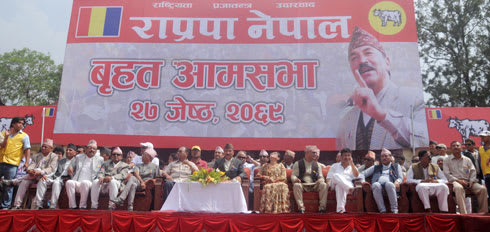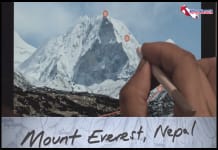While the Constituent Assembly (CA) got dissolved earlier this month as it couldn’t fulfill its duties and ran out of renewal options; discussions are now rife for who is who is it to blame for! And amidst all those, all allegations are put onto the leading party Maoists for taking wrong decisions of dissolving CA and announcing date for fresh CA elections by the joint 22 opposition parties.
The 22 opposition parties including big forces of Congress (NC) and CPN-UML also organised an agitation protesting the Maoists decision of fresh CA elections. Calling the decision “unilateral move”; the group blamed Prime Minister Baburam Bhattarai and the UCPN (Maoist) party chairman Pushpa Kamal Dahal for dissolving the CA and allegedly announcing fresh polls for November.
Here’s a short video of 22 opposition parties Protest in Kathmandu.
All of the 22 agitating groups had one clear voice – PM Baburam Bhattarai should step down and pave the way for formation of consensus government.
And just a day after the protest organised by 22 opposition parties; another protest is taking place today at Khullamanch in Kathmandu by the pro-royalist Rastriya Prajatantra Party Nepal (RPP-N).
 What do you say about the protests?
What do you say about the protests?
















[…] Nepali blogger posts photos and videos of yesterday's protests of 22 opposition parties in Kathmundu. Tweet Nepali blogger posts photos and videos of yesterday's protests of 22 opposition parties in Kathmundu. […]
Respected Redears and Democratic World!
We Nepalese people are suffering from the traitors-Congress, UML, Maoist, who are in regime. The term of the Constituent Assembly had ended at midnight of 27 May 2012, with failure to promulgate a constitution. And the Interim constitution, President, PM as well as the council minister has expired. But, this ended the relevance of Prime Minister Baburam Bhattarai’s cabinet, the presidential apparatus and all elements formed under the interim constitution of 2006. The President and Prime Minister, without constitutional mandate, are legally debarred from exercising any constitutional right.
The Constituent Assembly failed to promulgate the constitution within the stipulated time span of two years. Its term was repeatedly extended and the work of drafting the new constitution could still not be completed in four years time, climaxing with the dissolution of the Constituent Assembly. With their failure to draft a new constitution, party leaders betrayed the nation and the people. The interim constitution 2006 that was introduced for the management of the Constituent Assembly has no meaning after the dissolution of the latter. The interim constitution 2006 stands automatically dissolved as the new constitution was not drafted in time. This means that the 1990 constitution with the constitutional monarchy stands automatically revived.
Nepal Students’ Union founder-coordinator, Nepali Congress leader and veteran senior advocate Devendra Nepali wrote in a daily newspaper, “If the interim constitution 2006 fails to draft a new constitution then it will automatically dissolve and become defunct. The existence of the political parties was accepted as per the 1990 constitution; in this sense the 1990 constitution is seen as the legal parent of the political parties. It was established by the 1990 constitution viewing the people as sovereign. The dissolution of the interim constitution will automatically revive and activate the constitutional monarchy, multiparty parliamentary system and all other organs and institutions under 1990 constitution. It is fallacious to posit a nation without a constitution when the legality of the 1990 constitution revives.” If not implement the 1990 constitution the situation would have created uncertainty, confusion and anarchy in Nepal.
There are abundant examples round the world to establish that when an interim constitution collapses, the previous constitution (of 1990 in the case of Nepal) is automatically revived. After Indonesia’s independence in 1949, elections to the Constituent Assembly were held. But the failure to promulgate the new constitution within the stipulated time span compelled the country to revert to an old constitution, which was then suitably amended to serve their needs. In Pakistan, the Constituent Assembly was elected and for five years it dabbled with the work of drafting the new constitution inconclusively, till they reverted to the 1935 constitution drafted by the English to announce fresh elections. The constitution finally came through the newly elected parliament. In Britain, the republic system ran from 1649 to 1661 and collapsed. After 11 years, the monarchy was reinstated with the constitution and system that was prevalent during the days preceding the republic. In Spain, the republic system was introduced in 1936, but in 1969 the monarchy returned along with the old system.
Likewise, Cambodia became a republic in 1970 but in 1993 the people chose the royal institution and reinstated the law and constitution preceding the 1970 revolution. Hence, the dissolution of the Constituent Assembly in Nepal means the revival of the 1990 constitution. The parliament abolished by the Nepali Congress-led government was reinstated four years later after an agreement with the King on 24 April, 2011. Why shouldn’t we revive the 1990 constitution as it frees the nation from current crisis? With the demise of the Constituent Assembly, the constitution of 1990 constitution is restored automatically and Nepal’s royal institution, Nepal Army and people of Nepal are protectors of Nepal. The monarchy was pivotal in integrating Nepal, establishing democratic and equitable society at par with the modern world.
Only this option will open the doors for political resolution in Nepal. Nationality is a sensitive issue and will be difficult to re-establish once it rolls down the slope. In the past, Nepal was defended at the joint initiative of the King and people. Now that thread of unity has snapped. To rescue this holy land from an imminent dark future, all patriotic forces, the Nepalese monarchy, and the people, the Nepal Army, court and the chief organs of the State must all unite and defend the nation from chaos.
Email:[email protected]
I am no longer sure where you’re getting your info, however good topic. I needs to spend some time learning more or understanding more. Thanks for fantastic info I was in search of this info for my mission.
[…] ng isang taga-Nepal sa kanyang blog [en] ang mga kuhang litrato at bidyo sa ginanap na demonstrasyon noong ika-9 ng Hunyo sa siyudad ng […]
Great web site. Lots of useful information here. I’m sending it to some buddies ans also sharing in delicious. And obviously, thank you to your sweat!
Comments are closed.